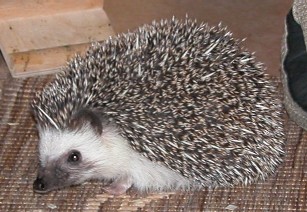
A hedgehog is a spiny mammal of the subfamily Erinaceinae, in the eulipotyphlan family Erinaceidae. There are seventeen species of hedgehog in five genera found throughout parts of Europe, Asia, and Africa, and in New Zealand by introduction. There are no hedgehogs native to Australia and no living species native to the Americas. However, the extinct genus Amphechinus was once present in North America.

Gymnures, also called hairy hedgehogs or moonrats, are mammals belonging to the subfamily Galericinae, in the family Erinaceidae and the order Eulipotyphla. Gymnures resemble rats but are not closely related as they are not rodents; they are instead closely related to hedgehogs, which also belong to Erinaceidae. They are thought to have appeared in Eastern Asia before their closest relatives, and changed little from the original ancestor, which is thought to have been also the ancestor of the shrews.

The greater kudu is a large woodland antelope, found throughout eastern and southern Africa. Despite occupying such widespread territory, they are sparsely populated in most areas due to declining habitat, deforestation, and poaching. The greater kudu is one of two species commonly known as kudu, the other being the lesser kudu, T. imberbis.

Erinaceidae is a family in the order Eulipotyphla, consisting of the hedgehogs and moonrats. Until recently, it was assigned to the order Erinaceomorpha, which has been subsumed with the paraphyletic Soricomorpha into Eulipotyphla. Eulipotyphla has been shown to be monophyletic; Soricomorpha is paraphyletic because both Soricidae and Talpidae share a more recent common ancestor with Erinaceidae than with solenodons.

The long-eared hedgehog is a species of hedgehog native to Central Asian countries and some countries of the Middle East. The long-eared hedgehog lives in burrows that it either makes or finds and is distinguished by its long ears. It is considered one of the smallest Middle Eastern hedgehogs. This hedgehog is insectivorous but may also feed on small vertebrates and plants. In captivity they can live for over 7 years.

The four-toed hedgehog, also known as the African pygmy hedgehog, is a species of hedgehog found throughout much of central and eastern Africa.

The moonrat is a southeast Asian species of mammal in the family Erinaceidae. It is the only species in the genus Echinosorex. The moonrat is a fairly small, primarily carnivorous animal which, despite its name, is not closely related to rats or other rodents. The scientific name is sometimes given as Echinosorex gymnurus, but this is incorrect.

The white-browed sparrow-weaver is a predominantly brown, sparrow-sized bird found throughout central and north-central southern Africa. It is found in groups of two to eleven individuals consisting of one breeding pair and other non-reproductive individuals.

The Namaqua sandgrouse, is a species of ground-dwelling bird in the sandgrouse family. It is found in arid regions of south-western Africa.

The North African hedgehog or Algerian hedgehog, is a mammal species in the family Erinaceidae native to Algeria, Libya, Malta, Morocco, Spain, and Tunisia. Little is known about this hedgehog, even though the most common breed of domesticated hedgehogs is a result of crossing a four-toed hedgehog with a North African hedgehog. Because this species of hedgehog is native to Africa, it has been suggested that it was introduced by humans to the other countries where it is now found, including Spain and the Canary Islands. Of the four African hedgehog species, the North African hedgehog is the only one of these hedgehogs that occurs outside Africa. Because the North African hedgehog has such a wide habitat range and has a seemingly stable population, both in the wild and in the domesticated capacity, it does not appear to currently be at risk.

Podogymnura truei, also known as the Mindanao gymnure, Mindanao moonrat, or Mindanao wood shrew, is a mammal of the family Erinaceidae. It is endemic to the Mindanao islands of the Philippines. Erinaceidae is a family of small mammals that include the gymnures, also known as the silky furred moonrats, and the hedgehogs. Animals belonging to this family are significant because they are among the oldest known placental mammals that are alive. Gymnures are relatives of hedgehogs but lack the prickly spines. Four species are categorized in the genus Podogymnura: P. aureospinula, P. intermedia, P. minima, and P. truei. All share a close resemblance to the moonrat Echinosorex gymnura, which is commonly found on the Borneo, Sumatra, and the Malay Peninsulas.

Moniliformidae is a family of parasitic spiny-headed worms. It is the only family in the Moniliformida order and contains three genera: Australiformis containing a single species, Moniliformis containing eighteen species and Promoniliformis containing a single species. Genetic analysis have determined that the clade is monophyletic despite being distributed globally. These worms primarily parasitize mammals, including humans in the case of Moniliformis moniliformis, and occasionally birds by attaching themselves into the intestinal wall using their hook-covered proboscis. The intermediate hosts are mostly cockroaches. The distinguishing features of this order among archiacanthocephalans is the presence of a cylindrical proboscis with long rows of hooks with posteriorly directed roots and proboscis retractor muscles that pierce both the posterior and ventral end or just posterior end of the receptacle. Infestation with Monoliformida species can cause moniliformiasis, an intestinal condition characterized as causing lesions, intestinal distension, perforated ulcers, enteritis, gastritis, crypt hypertrophy, goblet cell hyperplasia, and blockages.

Moniliformis is a genus of parasitic worms in the Acanthocephala phylum.

Trachylepis capensis is a species of skink, a lizard in the family Scincidae. The species is native to southern Africa.

















